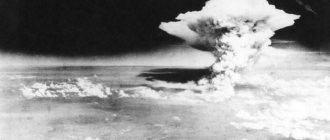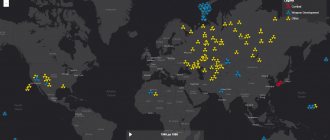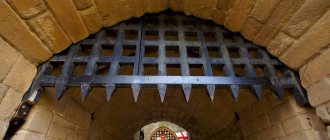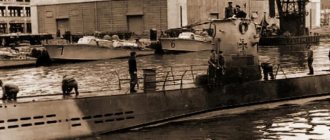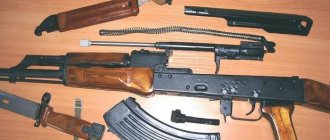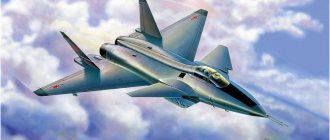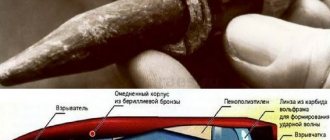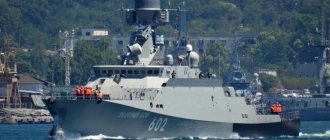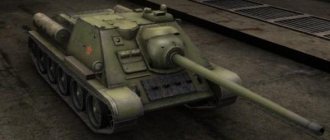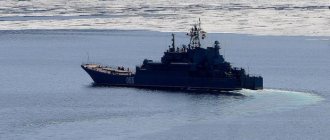Nuclear weapons are strategic weapons capable of solving global problems. Its use is associated with dire consequences for all humanity. This makes the atomic bomb not only a threat, but also a weapon of deterrence.
The appearance of weapons capable of putting an end to the development of mankind marked the beginning of a new era. The likelihood of a global conflict or a new world war is minimized due to the possibility of total destruction of the entire civilization.
Despite such threats, nuclear weapons continue to be in service with the leading countries of the world. To a certain extent, it is this that becomes the determining factor in international diplomacy and geopolitics.
A start
In April 1903, the famous French physicist Paul Langevin's friends gathered in the Paris Garden. The reason was the defense of the dissertation of the young and talented scientist Marie Curie. Among the distinguished guests was the famous English physicist Sir Ernest Rutherford. In the midst of the fun, the lights were turned off. Marie Curie announced to everyone that there would be a surprise. With a solemn look, Pierre Curie brought in a small tube with radium salts, which shone with a green light, causing extraordinary delight among those present. Subsequently, the guests heatedly discussed the future of this phenomenon. Everyone agreed that radium would solve the acute problem of energy shortages. This inspired everyone for new research and further prospects. If they had been told then that laboratory work with radioactive elements would lay the foundation for the terrible weapons of the 20th century, it is not known what their reaction would have been. It was then that the story of the atomic bomb began, killing hundreds of thousands of Japanese civilians.
Accusations
America was entering the years of McCarthyism. On December 21, 1953, shortly after Oppenheimer returned from England, where he had given a series of brilliant lectures on British radio and received a doctorate honoris causa from Oxford, he was urgently summoned to Washington by Lewis Strauss, who had by then become chairman of the Atomic Energy Commission. After a short conversation on the most banal topics, Strauss introduced Oppenheimer to the text of a letter from the commission’s director general, General Nichols.
The document Nichols drafted was an indictment based on reports that the Secret Service had filed in Oppenheimer's personnel file over the course of ten years.
The document Nichols drafted was an indictment based on reports that the Secret Service had filed in Oppenheimer's personnel file over a decade. At that time, the Associated Press summarized the main charges brought against the scientist as follows:
1. Dr. Oppenheimer maintained an ongoing relationship with the communists at the beginning of the war.
2. In 1949, as chairman of the Atomic Energy Commission Advisory Committee, he strongly opposed the development of the hydrogen bomb.
The letter expressed doubts about Oppenheimer's "truthfulness, behavior and even trustworthiness."
But already in advance, on December 3, President Eisenhower gave the order to “erect a blank wall between Oppenheimer and state secret information.”
Based on the Nichols document, an administrative hearing took place before the HR Committee of Princeton University. Its judges were the rector of the university, a prominent industrialist and a professor of chemistry.
In the end, nothing remained of the accusation that Oppenheimer was a Soviet agent. The committee acknowledged this. But Oppenheimer had visited communists in the past—that was enough. By a vote of two to one, belonging to the chemistry professor, it was decided that Oppenheimer was undesirable for any position involving access to military secrets, and his contract as adviser to the Atomic Energy Commission should be terminated.
Robert Oppenheimer. 1959
Philip Halsman
Playing ahead
On December 17, 1938, the German scientist Otto Gann obtained irrefutable evidence of the decay of uranium into smaller elementary particles. Essentially, he managed to split the atom. In the scientific world, this was regarded as a new milestone in the history of mankind. Otto Gann did not share the political views of the Third Reich. Therefore, in the same year, 1938, the scientist was forced to move to Stockholm, where, together with Friedrich Strassmann, he continued his scientific research. Fearing that Nazi Germany will be the first to receive terrible weapons, he writes a letter to the President of America warning about this. The news of a possible advance greatly alarmed the US government. The Americans began to act quickly and decisively.
Super and thermonuclear fusion
In the summer of 1942, even before the official launch of the Manhattan Project, Oppenheimer gathered a small group of theorists at Berkeley, consisting of his own students and several leading nuclear physicists (without false modesty, he called it “Lights”) to discuss the design of the atomic bomb. One of them was Edward Teller, a brilliant physicist who was born in Hungary and emigrated from Germany in 1933. He suggested that the “luminaries” do something more interesting than the atomic bomb, the theory of which was already clear in general terms.
In 1941, Fermi proposed the idea of a bomb that would be hundreds of times more powerful than an atomic one. The fact is that in addition to the nuclear decay reaction, like that of uranium or plutonium, a nuclear fusion reaction is possible, that is, the combination of two light nuclei into one heavier one. Moreover, if the result is an element lighter than iron, then the synthesis is energetically favorable, that is, the mass of the initial light nuclei is slightly greater than the mass of the heavy nucleus, and the difference, according to Einstein’s formula E = mc2, is released in the form of energy.
Edward Teller and the fusion reaction. Deuterium (an isotope of hydrogen with one extra neutron) and tritium (an isotope of hydrogen with two neutrons) combine to form helium, releasing energy
Share
The problem, however, is that nuclear forces are short-range - that is, the nuclei need to get very close to each other in order to enter into a fusion reaction. Since they are positively charged, this is counteracted by electrical repulsion. Repulsion can be overcome if the nuclei are forced to move very quickly by heating. But the repulsion is so strong that temperatures of hundreds of millions of degrees are needed, comparable to the temperature inside stars. For this reason, nuclear fusion reactions are also called thermonuclear reactions.
Under earthly conditions, the required temperature can only be achieved inside an atomic explosion. Having assigned Oppenheimer's students to deal with boring questions about the design of the atomic bomb, the "luminaries" took up a really interesting theoretical problem: is it possible to initiate a thermonuclear reaction by arranging an atomic explosion around thermonuclear fuel?
Another question arose that was more directly related to the use of the atomic bomb. Could an atomic explosion trigger a thermonuclear reaction involving nitrogen in the atmosphere or hydrogen in the ocean? “It would be a complete disaster. It’s better to give yourself into slavery to the Nazis than to hammer the last nail into the coffin of humanity!” - Hans Bethe recalled the doubts that gripped the “luminaries”.
Their calculations showed that an atomic explosion in air or water should not lead to a thermonuclear apocalypse, and a “super bomb,” even if possible, would require so much work that it certainly could not be created until the end of the war. Teller was very unhappy with this conclusion.
He was even more offended when Oppenheimer appointed Hans Bethe, rather than him, as head of the theoretical department of the laboratory. Bethe, in turn, had difficulty getting Teller to obey his instructions. As a result, Oppenheimer assigned Teller to work on the thermonuclear bomb, but this topic was a low priority, and Teller's group had only 6 employees.
One of these employees was Maria Geppert-Mayer. She was born and graduated from university in Germany. In 1930, she defended her dissertation in theoretical physics under the supervision of Max Born and met the American physicist Joseph Mayer, who came for an internship at the University of Göttingen. They married and moved to the United States, where Mayer received a position at a university.
At that time, American universities had strict rules against nepotism, which were supposed to prevent unfair hiring of employees for family protection, but in reality led to the fact that the wives of scientists were not able to build an academic career. The only thing Geppert-Mayer could count on were unpaid positions that provided access to a workplace and communication with colleagues, but did not bring money.
After the war, she finally took a position at the University of Chicago and began work on a shell model of the nucleus, which, among other things, could explain the mystery of nuclear magic numbers—why nuclei with a certain number of protons and neutrons are especially stable. For this work, Goeppert-Mayer received the Nobel Prize in Physics in 1963, becoming the second woman (after Marie Curie) to receive this award. The local newspaper (in 1960 Goeppert-Mayer became a physics professor at the University of California, San Diego) reported it this way: “San Diego mother wins Nobel Prize in Physics.”
Maria Geppert-Mayer and a clipping from The San Diego Tribune with the news of her being awarded the Nobel Prize
Share
The non-peaceful atom of Igor Kurchatov
Today, every schoolchild will be able to answer the question of who invented the atomic bomb in the Soviet Union. And then, in the early 30s of the last century, no one knew this.
In 1932, Academician Igor Vasilyevich Kurchatov was one of the first in the world to begin studying the atomic nucleus. Gathering like-minded people around him, Igor Vasilyevich created the first cyclotron in Europe in 1937. In the same year, he and his like-minded people created the first artificial nuclei.
In 1939, I.V. Kurchatov began studying a new direction - nuclear physics. After several laboratory successes in studying this phenomenon, the scientist receives at his disposal a secret research center, which was named “Laboratory No. 2”. Nowadays, this classified object is called “Arzamas-16”.
The target direction of this center was the serious research and creation of nuclear weapons. Now it becomes obvious who created the atomic bomb in the Soviet Union. His team then consisted of only ten people.
Verdict for the Japanese
On July 24, 1945, Truman decided to inform Stalin that the United States had new weapons of enormous destructive power. The President brought the information to the Soviet leader after the next meeting, during a farewell on the steps of the Cecilienhof Palace.
To Truman's surprise, Stalin did not ask him a single question. The US President decided that the Soviet leader simply did not understand what he was talking about.
In fact, Stalin knew much more than the American leader could imagine. The Soviet Union was already working on creating its own atomic bomb. Soviet intelligence officers managed to reach secret American cities involved in the Manhattan Project and received valuable information from there.
On the same day, July 24, Harry Truman approved a directive to the commander of strategic aviation, General Karl Spaatz: “After August 3, as soon as weather conditions allow visual bombing, the 509th Composite Air Regiment of the 20th Air Army is to drop the first special bomb on one of the following targets: Hiroshima, Kokura, Niigata, Nagasaki."
For tens of thousands of residents of Hiroshima and Nagasaki, the countdown to the last days of their lives has begun.
Hiroshima and Nagasaki: the story of the murder of Japanese cities
At the end of World War II, on July 26, 1945, the governments of the United States, Great Britain, and China signed the Potsdam Declaration, according to which Japan was to surrender unconditionally and immediately. Japanese Emperor Hirohito did not accept the ultimatum. Commons.wikimedia.org / Nuclear mushroom over Hiroshima and Nagasaki
To frighten the Japanese government and demonstrate to the world the significance and danger of using nuclear weapons, US President Harry Truman approved the order to bomb Japanese cities. Commons.wikimedia.org / Hiroshima before and after the explosion.
When selecting targets, the US military considered Kyoto, Hiroshima, Yokohama, Kokura and Niigata. Purely military targets were rejected, as the chance of missing a small area not surrounded by a large urban area was high due to fog. Commons.wikimedia.org / Enola Gay crew with Commander Paul Tibbetts in the center
The B-29 Enola Gay bomber, at an altitude of 9 km, dropped an atomic bomb on the center of Hiroshima on August 6, 1945 at 8.15 am. This was the first time in human history that nuclear weapons were used during hostilities against civilians. Commons.wikimedia.org / B-29 "Enola Gay" Bomber
The explosion occurred 45 seconds after the release, at a distance of 600 meters above the ground. The Little Boy bomb, with the equivalent of 13 to 18 kilotons of TNT, claimed the lives of 90 to 166 thousand residents of Hiroshima. Commons.wikimedia.org / Atomic explosion over Hiroshima
The people at the center of the explosion instantly turned to coal. Birds burned in the air, dry materials such as paper ignited automatically at a distance of up to 2 km from the epicenter of the explosion, glass in buildings was broken at a distance of up to 19 km. Commons.wikimedia.org / Burnt Japanese boy
One of the few residents of Hiroshima, who was at a distance of 300 m from the epicenter, wrote that for her three colors characterize the day of the tragedy: black, which cut off sunlight and plunged the city into darkness; red is the color of the blood of the wounded; brown is the color of burnt skin falling off the body. Commons.wikimedia.org / Victim of the Hiroshima bombing
Early in the morning of August 9, the USSR declared war on Japan, launching an attack on Manchuria. On the same day, the American military carried out a bombing attack on Nagasaki. At 11:02 am the bomber dropped the Fat Man bomb, which killed between 60 and 80 thousand people. Commons.wikimedia.org / Nagasaki before and after the explosion
On August 10, Emperor Hirohito of Japan broadcast his statement of surrender to the media, despite the fact that members of the Japanese government were equally divided into supporters and opponents of surrender. Commons.wikimedia.org / Statue of one of the Japanese gods on the ruins of Nagasaki
Due to the fact that the evacuation of people from radiation-contaminated areas was not carried out, the number of people affected by the explosion increased every day: as of March 31, 2013, it reached 450 thousand: 286,818 in Hiroshima and 162,083 in Nagasaki. flickr.com / Day of Remembrance for the Victims of the Atomic Bombing of Hiroshima and Nagasaki // Freedom II Andres
There will be an atomic bomb
By the end of 1945, Igor Vasilyevich Kurchatov managed to assemble a serious team of scientists numbering more than a hundred people. The best minds of various scientific specializations came to the laboratory from all over the country to create atomic weapons. After the Americans dropped an atomic bomb on Hiroshima, Soviet scientists realized that this could be done with the Soviet Union. “Laboratory No. 2” receives from the country’s leadership a sharp increase in funding and a large influx of qualified personnel. Lavrenty Pavlovich Beria is appointed responsible for such an important project. The enormous efforts of Soviet scientists have borne fruit.
Stockpiles of nuclear weapons in the world
Stockpiles of nuclear weapons in the world
The main stockpiles of nuclear weapons are concentrated in Russia and the United States. In addition to them, the following countries have atomic bombs:
- Great Britain - since 1952;
- France - since 1960;
- China - since 1964;
- India - since 1974;
- Pakistan - since 1998;
- DPRK - since 2008.
Israel also possesses nuclear weapons, although there has been no official confirmation from the country's leadership.
There are US bombs on the territory of NATO countries: Germany, Belgium, the Netherlands, Italy, Turkey and Canada. The US allies, Japan and South Korea, also have them, although the countries have officially abandoned the location of nuclear weapons on their territory.
After the collapse of the USSR, Ukraine, Kazakhstan and Belarus briefly had nuclear weapons. However, it was later transferred to Russia, which made it the sole heir to the USSR in terms of nuclear weapons.
The number of atomic bombs in the world changed during the second half of the 20th century and the beginning of the 21st century:
- 1947 - 32 warheads, all from the USA;
- 1952 - about a thousand bombs from the USA and 50 from the USSR;
- 1957 - more than 7 thousand warheads, nuclear weapons appear in Great Britain;
- 1967 - 30 thousand bombs, including weapons from France and China;
- 1977 - 50 thousand, including Indian warheads;
- 1987 - about 63 thousand, - the highest concentration of nuclear weapons;
- 1992 - less than 40 thousand warheads;
- 2010 - about 20 thousand;
- 2018 - about 15 thousand.
It should be borne in mind that these calculations do not include tactical nuclear weapons. This has a lower degree of damage and variety in carriers and applications. Significant stocks of such weapons are concentrated in Russia and the United States.
Semipalatinsk test site
The atomic bomb in the USSR was first tested at the test site in Semipalatinsk (Kazakhstan). On August 29, 1949, a nuclear device with a yield of 22 kilotons shook the Kazakh soil. Nobel laureate physicist Otto Hanz said: “This is good news. If Russia has atomic weapons, then there will be no war.” It was this atomic bomb in the USSR, encrypted as product No. 501, or RDS-1, that eliminated the US monopoly on nuclear weapons.
Principle of operation
The principle of operation is the combination of charges to create a critical mass and a subsequent chain reaction.
The principle of operation of an atomic bomb is based on a chain reaction of the decay of heavy nuclei or thermonuclear fusion of light ones. During these processes, a huge amount of energy is released, which turns the bomb into a weapon of mass destruction.
The principle of a nuclear bomb explosion has several damaging factors:
- light flash;
- radioactive contamination;
- shock wave;
- penetrating radiation;
- electromagnetic pulse.
A flash of light, accompanied by thermal radiation, is formed first. Its power significantly exceeds the power of the sun's rays, which makes the explosion dangerous at a distance of several kilometers from the epicenter.
Radiation also poses a danger: within a minute its penetrating power is highest. In the future, it causes radiation sickness in humans and animals.
The shock wave has a high degree of damage at a distance of several hundred meters from the epicenter. There is nothing alive or whole left in this radius. As you move away from the center, the degree of damage decreases.
An electromagnetic pulse (EMP), the most “harmless” consequence of a nuclear explosion, leads to the shutdown of electronics. It causes harm to living organisms if they are dependent on electronic devices. At the same time, lamp and photonic equipment has good resistance to EMR.
Japan will not capitulate
By the time of the final and successful testing of the atomic bomb, Soviet troops and allies had finally defeated Nazi Germany. However, there was one state that promised to fight to the end for dominance in the Pacific Ocean. From mid-April to mid-July 1945, the Japanese army repeatedly carried out air strikes against allied forces, thereby inflicting heavy losses on the US army. At the end of July 1945, the militaristic Japanese government rejected the Allied demand for surrender under the Potsdam Declaration. It stated, in particular, that in case of disobedience, the Japanese army would face rapid and complete destruction.
Special Forces Regiment
Even before the first atomic bombs were built, in the summer of 1944, a special 509th air regiment was created. Its pilots flew specially designed B-29 bombers with extended bomb bays. Unlike their colleagues, the pilots of the 509th Aviation Regiment practiced the same technique: approaching the target in normal weather, dropping, and then quickly turning around and moving to a safe distance so that the carrier would not be destroyed by powerful air currents. The command believed that by the time the 509th Air Regiment received a combat order, resistance from enemy air defenses and fighters would be reduced to a minimum.
By June 1944, the Manhattan Project employed approximately 129,000 employees, of whom 84,500 were construction workers, 40,500 were operators, and 1,800 were military personnel. Then the number of military personnel increased to 5,600.
Article on the topic
Stalin's atomic bluff. The Kharkov bomb was made by the Germans, and the States detonated it in Japan
The President agrees
The American government kept its word and began a targeted bombing of Japanese military positions. Air strikes did not bring the desired result, and US President Harry Truman decides to invade Japanese territory by American troops. However, the military command dissuades its president from such a decision, citing the fact that an American invasion would entail a large number of casualties.
At the suggestion of Henry Lewis Stimson and Dwight David Eisenhower, it was decided to use a more effective way to end the war. A big supporter of the atomic bomb, US Presidential Secretary James Francis Byrnes, believed that the bombing of Japanese territories would finally end the war and put the United States in a dominant position, which would have a positive impact on the further course of events in the post-war world. Thus, US President Harry Truman was convinced that this was the only correct option.
Los Alamos
As a youth, Oppenheimer spent summers on a ranch in the mountains of New Mexico and fell in love with the area. He once remarked in a letter to a friend: “My two great loves are physics and the desert. It’s a pity that they can’t be combined.” However, this is exactly what Groves needed - a laboratory with the most talented physicists in the United States, located so far away that there was no need to worry about information leaks or sabotage by enemy spies. At the suggestion of Oppenheimer, in November 1942, the US government bought the territory of the Los Alamos private school, located in the mountains 56 km from the capital of New Mexico, Santa Fe.
Mountains near Los Alamos
Share
Scientists persuaded by Oppenheimer to join the Manhattan Project began moving to Los Alamos in early 1943. Initially, Oppenheimer expected that he would need about 50 research assistants and another 50 laboratory assistants. In reality, the population of Los Alamos (including family members of laboratory employees) was 3,500 people already in 1943 and almost 10,000 by the end of 1945.
Living conditions in Los Alamos were far from ideal, especially for those who were used to living in comfortable European cities (Leo Szilard was afraid that he would go crazy there). In addition, with such a rate of population growth, despite continuous construction, there was a constant shortage of housing.
Leading scientists such as Oppenheimer, Fermi or Teller moved into the houses where Los Alamos teachers had once lived. Since these were the only houses with baths, the street on which they stand is still called Bathtub Row.
Share
Lesser-known scientists and technical staff lived in dormitories and trailers
Share
Another source of constant irritation for scientists was the secrecy and security measures established by General Groves. Los Alamos was surrounded by a fence, and another fence with barbed wire was built around the technical area where the laboratories were located. This unnerved some European emigrants because it reminded them of concentration camps. All residents, except small children, were required to wear name and photograph badges, the color of which determined where the badge holder had access. There were only 3 telephones in Los Alamos, and mail was censored. Residents were forbidden to tell where they lived, with whom and what they were working on.
Fence around the technical area at Los Alamos
Share
Poster from Los Alamos: "Your pen and tongue can be the enemy's weapon"
Share
The military believed that one of the most effective ways to combat leaks was to limit the spread of information within the Manhattan Project itself. Oppenheimer managed to defend the right of scientific workers to receive information about the progress of the entire project, and not just that which related to the narrow task in which they were directly involved, but scientists were strictly forbidden to tell anything even to their spouses (which made the life of the spouses in Los Alamos even more bleak) . Moreover, engineers and laboratory assistants were given the bare minimum of information they needed to do their work. Thus, one of the employees of a uranium enrichment plant found out that she participated in the work on the atomic bomb only after seeing herself in a photograph in a museum where she came on an excursion.
The same photo. Plant for electromagnetic separation of uranium isotopes. The employees did not know that they were working in a nuclear project
Share
Despite everyday difficulties, almost none of the scientists invited by Oppenheimer refused to move to Los Alamos. They believed that this was a chance to contribute to the fight against Hitler and the liberation of Europe, and indecision and delay were like death - the Germans, who were the first to discover the decay of uranium back in 1938, had an obvious head start in time.
After the successful evacuation of Niels Bohr from Denmark to Great Britain at the end of 1943, the British government decided to transport him to Los Alamos, where, under the pseudonym Nicholas Baker (at the insistence of Groves), he joined the British mission of scientists led by the discoverer of the neutron, James Chadwick, as a consultant.
Bohr's appearance at Los Alamos inspired many employees. Oppenheimer recalled after the war: “The drill at Los Alamos was magnificent. He was very keenly interested in technical details, but that was not what really mattered to almost all of us. He convinced us that we were doing an important job, while many were tormented by doubts.”
Party at the house of Robert Oppenheimer (he is in the photo on the right). Residents of Los Alamos needed to sometimes take a break from their busy work, and they threw wild parties with dancing and drinking. Jean Bacher, wife of the head of the experimental physics department, Robert Bacher, recalled: “Usually evenings with scientists go like this: the men gather in the corner and talk about what interests them. But there were amazing conversations at Los Alamos, we finally had the opportunity to talk about something other than science - men couldn’t discuss what they were working on in front of us!”
Share
Physicists at Los Alamos were working on a bomb of unprecedented power, which in the future could claim many lives. Bohr's stories about his meeting with Heisenberg, which convinced him of the seriousness of the German atomic project (which we talked about in the material “They Make You Think About War”), and about the crimes of the Nazis in Europe strengthened their confidence that they were doing the right thing.
Undermining "presidents"
Physicists and engineers have developed two alternative designs for the atomic bomb: the cannon bomb and the implosion bomb.
In a simpler cannon design, the critical mass of fissile material was divided into two parts - a target and a bullet, which were placed in the cannon barrel. At the moment the bomb was detonated, the bullet was accelerated with the help of conventional explosives, and, hitting the target, formed a critical mass with it, which led to a self-sustaining chain reaction and a powerful nuclear explosion. This design, however, was only suitable for a uranium bomb and not suitable for a plutonium one. In an implosion bomb (from implosion - explosion inward), the fissile substance (plutonium) was wrapped in ordinary explosives, which were detonated at the same time. The shock wave from the explosion compressed the plutonium, bringing it to a critical state (that is, making it so dense that the neutrons resulting from fission hit other nuclei without having time to fly beyond the boundary of the substance) and a nuclear explosion. The size of atomic bombs was very large, and so the Americans had to modify their largest bomber, the Boeing B-29 Superfortress, to fit into the bomb bay. In 1945, American pilots began training to drop dummy atomic bombs from modified B-29s. For the purpose of secrecy in negotiations, the thin and long “cannon” bomb was called “thin man” (in Russian the translation “Baby” was fixed), and the thicker and more rounded impressive “fat man” (“Fat Man”). The pilots pretended to be preparing to transport the thin US President Franklin Roosevelt and the fat British Prime Minister Winston Churchill. Share
Franklin Roosevelt and Winston Churchill at the Tehran Conference in 1943
Share
Atomic bomb. Hiroshima
The small Japanese city of Hiroshima with a population of just over 350 thousand people, located five hundred miles from the Japanese capital Tokyo, was chosen as the first target. After the modified B-29 Enola Gay bomber arrived at the US naval base on Tinian Island, an atomic bomb was installed on board the aircraft. Hiroshima was to experience the effects of 9 thousand pounds of uranium-235.
This never-before-seen weapon was intended for civilians in a small Japanese town. The bomber's commander was Colonel Paul Warfield Tibbetts Jr. The US atomic bomb bore the cynical name “Baby”. On the morning of August 6, 1945, at approximately 8:15 a.m., the American “Little” was dropped on Hiroshima, Japan. About 15 thousand tons of TNT destroyed all life within a radius of five square miles. One hundred and forty thousand city residents died in a matter of seconds. The surviving Japanese died a painful death from radiation sickness.
They were destroyed by the American atomic “Baby”. However, the devastation of Hiroshima did not cause the immediate surrender of Japan, as everyone expected. Then it was decided to carry out another bombing of Japanese territory.
Commonwealth of Physicist and General
The preparatory work has been completed. On August 13, 1942, the White House decided to begin work on the direct creation of an atomic bomb. The project was codenamed "Manhattan".
General Leslie Groves and physicist Robert Oppenheimer were appointed project leaders . The entire scientific part was entrusted to Oppenheimer, and Groves had to deal with administrative issues and control over scientists who were not accustomed to strict secrecy and military discipline.
The budget for the Manhattan Project was an astronomical sum of two billion dollars. But such expenses made it possible to move in several ways at once. Thus, the dispute about which bomb to create—uranium or plutonium—was resolved by an order to create both.
To accumulate reserves of weapons-grade plutonium, the city of Hanford was created, in which three special nuclear reactors were built. Another city built from scratch, Oak Ridge, arose thanks to the uranium enrichment facility built there.
In November 1942, construction began on the secret city of Los Alamos in New Mexico. It was in this city that it was planned to build the world's first atomic bombs.
Installation of K-25 in Oak Ridge. Photo: Public Domain
Nagasaki. The sky is on fire
The American atomic bomb “Fat Man” was installed on board a B-29 aircraft on August 9, 1945, still there, at the US naval base in Tinian. This time the aircraft commander was Major Charles Sweeney. Initially, the strategic target was the city of Kokura.
However, weather conditions did not allow the plan to be carried out; heavy clouds interfered. Charles Sweeney went into the second round. At 11:02 a.m., the American nuclear “Fat Man” engulfed Nagasaki. It was a more powerful destructive air strike, which was several times stronger than the bombing in Hiroshima. Nagasaki tested an atomic weapon weighing about 10 thousand pounds and 22 kilotons of TNT.
The geographic location of the Japanese city reduced the expected effect. The thing is that the city is located in a narrow valley between the mountains. Therefore, the destruction of 2.6 square miles did not reveal the full potential of American weapons. The Nagasaki atomic bomb test is considered the failed Manhattan Project.
"Doctor Groves is pleased"
In order to maintain secrecy and not cause panic among the local population, the version invented by General Groves was transmitted to the press. The Associated Press reported: “At dawn on July 16, an ammunition depot exploded in the desert near Alamogordo Air Force Base, New Mexico. The explosion was so strong that it attracted attention in Gallup, 376 kilometers away.”
On the evening of July 16, 1945, Harry Truman, who was in Potsdam, received a coded message: “The operation was performed this morning. The diagnosis is not yet complete, but the results seem satisfactory and already exceed expectations. Dr. Groves is pleased."
This meant that the atomic bomb tests were successful. The US President was jubilant - he had received a powerful argument to influence the Russians. At the very first meetings of the Potsdam Conference, he began to conduct the discussion decisively, being confident in the strength of his positions.
Japan surrendered
At noon on August 15, 1945, Emperor Hirohito announced his country's surrender in a radio address to the people of Japan. This news quickly spread around the world. Celebrations began in the United States of America to mark the victory over Japan. The people rejoiced.
On September 2, 1945, a formal agreement to end the war was signed aboard the American battleship Missouri anchored in Tokyo Bay. Thus ended the most brutal and bloody war in human history.
For six long years, the world community has been moving towards this significant date - since September 1, 1939, when the first shots of Nazi Germany were fired in Poland.
Operation Trinity
The “Thing” was chosen for the first atomic test in history. The explosion was scheduled for July 16, 1945 at the Alamogordo test site. The charge was installed on a thirty-meter steel tower surrounded by measuring equipment. Three observation posts were set up within a radius of ten kilometers, and a dugout for a command post was set up at a distance of 16 kilometers.
Article on the topic
Peace as a gift. How the atomic bomb saved millions of lives
The first atomic test was codenamed Trinity. There were a lot of forecasts regarding its results - from complete failure to a global catastrophe that would destroy the planet. But Oppenheimer hoped that the bomb would correspond to the planned power.
The testing was in jeopardy due to disgusting weather in the area of the test site. Oppenheimer almost quarreled with Groves . The military leader insisted on testing in any case, and the scientific one pointed out that with strong winds, a radioactive cloud could cover nearby American cities.
But by 5:30 am the weather had normalized, and the explosion was carried out at the estimated time.
The effect exceeded expectations. The power of the explosion was about 18 kilotons of TNT. The crater after the explosion was about 76 meters in diameter. The shock wave spread over 160 kilometers, and the mushroom cloud rose to a height of 12 kilometers.
When the cloud cleared, scientists and military personnel went to the epicenter in tanks lined with lead plates on the inside. What they saw made a different impression on them. The military rejoiced, and the physicists were depressed, realizing what kind of genie had just been released from the bottle.
Peaceful atom
In total, 124 nuclear explosions were carried out in the Soviet Union. What is characteristic is that all of them were carried out for the benefit of the national economy. Only three of them were accidents that resulted in the leakage of radioactive elements. Programs for the use of peaceful atoms were implemented in only two countries - the USA and the Soviet Union. Nuclear peaceful energy also knows an example of a global catastrophe, when on April 26, 1986, a reactor exploded at the fourth power unit of the Chernobyl nuclear power plant.
Is there light at the end of the tunnel?
How the “birth in Alamogordo” turned out for the entire post-war world order and how today they are trying to contain the process of proliferation of nuclear weapons, we analyze together with PIR Center experts, scientists and diplomats.
More recently, speaking at the online session of the Primakov Readings, the head of the Center for International Security at IMEMO RAS, Alexei Arbatov, warned that the modern world “could be thrown back to the 1950s, when there was nuclear deterrence, but there was no arms control system.” . Then, Alexey Arbatov recalled, the world had reached its breaking point, and the Cuban Missile Crisis of 1962 was caused by an unrestrained arms race. “Only a miracle saved the world from disaster,” the expert said.
What do we see now? Expeditionary trips between Russia and the United States within the framework of the Strategic Arms Reduction Treaty have been stopped. The Conference of the Parties to the Treaty on the Non-Proliferation of Nuclear Weapons has been postponed for a year. Washington announced its decision to withdraw from the Open Skies Treaty, and a crisis is growing over President Trump's position regarding the plan to resolve the Iranian nuclear program.
Moreover, according to Arbatov, in the United States there was even serious talk about withdrawing from the Comprehensive Nuclear Test Ban Treaty. “It was concluded in 1996 and took 33 years to prepare. It is the greatest achievement that since 1996, no country except North Korea has conducted nuclear tests, and North Korea stopped last year... But if the United States leaves, then not only this treaty will collapse, but also the NPT, because these two the treaties are very closely related,” warned the head of the IMEMO Center for International Security.
Academician of the Russian Academy of Sciences Sergei Rogov, scientific director of the Institute of the USA and Canada, also agrees with him on many points. In his opinion, if the START III treaty is not extended or an adequate replacement is not proposed, “then the nuclear arms control regime, which has existed for several decades and was the basis of strategic stability, will completely collapse.” And without this kind of agreement, “nuclear chaos will begin, a game without rules,” when everyone acts according to their own concepts and ideas, as was the case at the very beginning of the nuclear arms race.
“Of course, the termination of the START-3 treaty is not the end of the world,” Interfax quotes academician Rogov. “But the absence of this treaty will have extremely negative consequences and may ultimately lead to the end of the world, if by this we mean nuclear war.”
Is there an alternative to this? So as not to count and control, but to do away with atomic bombs, warheads and their carriers once and for all?
“In order to rid the world of nuclear weapons, there must be universal harmony, which, unfortunately, can hardly be expected,” said the chairman of the PIR Center board and co-chairman of the international club “Trialogue”, retired lieutenant general Evgeniy Buzhinsky.
To support his position, he refers to past experience and events of recent years. All conflicts, US actions to destroy existing international political, trade, economic and other mechanisms, strengthening the military presence in Europe - all this interferes with the process of general disarmament, the expert believes.
To rid the world of nuclear weapons, universal harmony must come, and this is not predicted in the foreseeable future on both sides of the ocean
“What might a plan for general disarmament look like? - Evgeny Buzhinsky asks the question and answers it himself. — Such a plan already exists - this is article six of the NPT, according to which countries that have nuclear weapons are obliged to strive for disarmament. It is pointless and useless to force them into a certain time frame. Even if we set a goal of reducing nuclear weapons by a third by 2025, the slightest complications in international relations could completely stop the process. Difficulties will arise in one of the “hot spots”, be it in the Middle East or Southeast Asia. Key players are likely to intervene in the regional crisis: the United States, Russia or China - there will be a clash of interests that will lead to a halt in the disarmament process. In this regard, I believe that complete nuclear disarmament is currently impossible.”
The PIR Center expert recalled a scene from the series “Seventeen Moments of Spring,” where Oleg Tabakov’s character says: “Müller is immortal, just as detective is immortal in this world.” General Buzhinsky applies the same words to nuclear weapons.
The “mushroom” season, opened 75 years ago in Alamogordo, was continued in Nevada, near Semipalatinsk, on Novaya Zemlya, Moruroa Atoll and in other not so well-known nuclear testing sites. Photo: Gettyimages
How it was
I was extremely interested in carrying out the test as scheduled, because I knew what significance this event could have in the Potsdam negotiations. In addition, every extra day of delay in the test meant an extra day of war. And not because we will be late in making bombs, but because a delay in the Potsdam decisions will delay Japan's response and, therefore, delay the day of the atomic bombing.
From a purely technical point of view, it was also desirable to carry out the test as quickly as possible, since every extra hour that the electrical connections were exposed to a very damp environment increased the likelihood of a misfire. The electrical connections in the devices and in the wires leading to them, which were not made as carefully as the electrical part of the bomb itself, could be even more damaged. In addition, every extra hour increased the likelihood that someone would attempt to interfere with the test. Our people were in a state of extreme nervous tension, and the possibility was not excluded that one of them would not be able to withstand it. As a result, Oppenheimer and I agreed not to postpone the test for a day, but to wait another two hours.
Our preparations were simple. Everyone was ordered, when the count reached zero, to lie down with their face to the ground and their feet in the direction of the explosion, close their eyes and cover them with their palms. As soon as the explosion occurred, you were allowed to get up and look through the smoked glass that everyone was equipped with... I lay on the ground between Bush and Conant and thought only about what I should do if nothing happened when the score was “zero”...
The explosion occurred at 5:30 am. There was a feeling of a very bright light filling everything around, and when I turned around, I saw the now familiar picture of a fireball. My first reaction, as well as Bush's and Conant's, while we were still sitting on the ground watching this spectacle, was a silent exchange of handshakes.
Shortly after the explosion, Farrell and Oppenheimer, along with the other people at the control point, returned to the camp. Farrell's first words when he approached me were: "The war is over." I replied, “Yes, but after we drop two more bombs on Japan.”
Leslie Groves. Now we can talk about it.
Infographics "RG" / Anton Perepletchikov / Alexander Emelyanenkov
Meanwhile
How does a nuclear bomb work?
Structurally, an atomic bomb consists of a large number of components, the main ones being the body and automation. The housing is designed to protect automation and nuclear charge from mechanical, thermal, and other influences. Automation controls the timing of the explosion.
It includes:
- Emergency explosion.
- Cocking and safety devices.
- Power supply.
- Various sensors.
Transportation of atomic bombs to the site of attack is carried out using missiles (anti-aircraft, ballistic or cruise). Nuclear ammunition can be part of a landmine, torpedo, aircraft bomb and other elements. Various detonation systems are used for atomic bombs. The simplest is a device in which the impact of a projectile on a target, causing the formation of a supercritical mass, stimulates an explosion.
Nuclear weapons can be of large, medium and small caliber. The power of the explosion is usually expressed in TNT equivalent. Small-caliber atomic shells have a yield of several thousand tons of TNT. Medium-caliber ones already correspond to tens of thousands of tons, and the capacity of large-caliber ones reaches millions of tons.
Operating principle
The operation of an atomic bomb is based on the principle of using nuclear energy released during a nuclear chain reaction. This process involves the fission of heavy or fusion of light nuclei. Due to the release of a huge amount of intranuclear energy in the shortest period of time in a small space, a nuclear bomb is classified as a weapon of mass destruction.
During this process, there are two key places:
- the center of a nuclear explosion in which the process directly takes place;
- the epicenter, which is the projection of this process onto the surface (of land or water).
A nuclear explosion releases such an amount of energy that, when projected onto the ground, causes seismic tremors. The range of their spread is very large, but significant damage to the environment is caused at a distance of only a few hundred meters.
